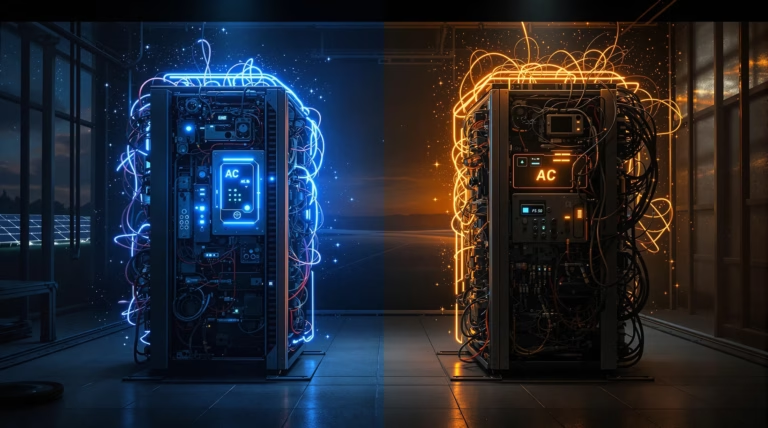AC Battery vs DC Battery: Key Differences Explained
Making an informed decision about battery storage systems requires understanding the fundamental differences between AC and DC batteries. Let’s explore their unique characteristics, applications, and how they can best serve your energy storage needs.
Understanding AC and DC Batteries
When exploring battery storage technologies, understanding the fundamental difference between AC (Alternating Current) and DC (Direct Current) batteries is essential. These systems differ in how they store, convert, and deliver electrical energy, which significantly impacts their application and efficiency in various scenarios.
All batteries intrinsically store energy as Direct Current, where electricity flows consistently in one direction. However, the distinction between AC and DC batteries lies in how they integrate with electrical systems and the conversion processes they employ. This differentiation becomes particularly important when connecting batteries to household appliances, solar panels, or the power grid, as each requires specific current types for optimal operation.
What is an AC Battery?
An AC battery isn’t technically a battery that stores alternating current—rather, it’s a battery system that includes an integrated inverter to convert the stored DC electricity into AC power for use in standard household appliances and the grid. These systems are designed to seamlessly interface with AC electrical systems without requiring additional conversion equipment.
The key component of an AC battery system is its built-in inverter, which transforms the DC electricity stored in the battery cells into the alternating current that powers most homes and businesses. This integration allows for a more streamlined connection to existing electrical infrastructure. AC batteries are particularly valuable in retrofitting scenarios where homeowners add energy storage to an existing grid-tied system, as they can be installed alongside the electrical panel without major system modifications.
What is a DC Battery?
A DC battery stores and delivers electrical energy in its native direct current form. These battery systems maintain energy in the same format that solar panels generate electricity, creating a natural synergy for solar applications. Unlike AC batteries, DC batteries don’t have built-in inverters—they connect directly to a solar system’s charge controller and share the main system inverter.
The direct DC connection offers several advantages, particularly in new solar installations:
- Higher efficiency rates due to fewer conversion steps
- Better performance in off-grid applications
- Optimal for maximizing self-consumption of solar energy
- Superior performance for long-term energy storage
- Reduced energy loss during storage and retrieval process
Key Differences Between AC and DC Batteries
| Feature | AC Batteries | DC Batteries |
|---|---|---|
| Integration | Connect to AC grid mains | Connect directly to solar panels |
| Inverter Setup | Dedicated inverter required | Shares inverter with solar system |
| Efficiency | 90-94% | Up to 98% |
| Best Use Case | Retrofitting existing systems | New solar installations |
Efficiency and Cost Considerations
Energy efficiency represents one of the most significant differences between these battery types. DC-coupled systems typically achieve efficiency ratings of approximately 98%, while AC-coupled alternatives generally range between 90-94%. This efficiency gap stems from the reduced number of conversions in DC systems, resulting in less energy loss during the storage and retrieval process.
Installation and Retrofitting
Installation requirements differ substantially between these battery types, particularly when adding storage to existing solar installations. AC-coupled batteries excel in retrofitting scenarios as they can integrate more easily with established systems, connecting directly to the home’s AC circuits without requiring significant modifications to the original solar setup.
DC-coupled batteries, while offering superior efficiency, are typically better suited for new solar installations where the entire system can be designed cohesively from the outset. Recently, PV-coupled LFP (Lithium Iron Phosphate) solar batteries have emerged as an effective middle-ground solution, offering improved retrofit capabilities while maintaining many of the efficiency advantages of traditional DC-coupled systems.
Applications and Use Cases
Both AC and DC battery systems have found their place in modern energy solutions, with each excelling in specific applications based on their inherent characteristics. Historically, AC-coupled battery energy storage systems (BESS) have dominated residential and commercial solar installations, while DC-coupled systems were primarily deployed in remote and off-grid scenarios.
The fundamental difference in how these systems handle electrical current drives their application diversity. AC batteries interface seamlessly with the power grid, which transmits electricity as alternating current over long distances with minimal loss. Meanwhile, DC batteries work naturally with solar panels, which generate direct current, making them particularly effective in renewable energy capture and storage applications.
Applications and Use Cases
AC and DC Batteries in Home Solar Systems
The integration of battery storage with home solar systems varies significantly between AC and DC configurations. In AC-coupled systems, solar-generated electricity undergoes multiple conversions: DC to AC through the solar inverter, back to DC for battery storage, and finally to AC for household use. While this triple-conversion process facilitates easy retrofitting, it results in efficiency losses at each conversion point.
DC-coupled systems provide a more efficient approach, especially for new solar installations. They enable direct DC electricity flow from solar panels to batteries without initial conversion, requiring only one inversion step when using stored energy. This streamlined pathway achieves system efficiency of approximately 98%, compared to 90-94% in AC-coupled systems. The emerging PV-coupled LFP solar batteries offer an innovative middle ground, combining improved retrofit capabilities with the efficiency benefits of DC coupling.
Role in Electric Vehicle Charging
DC battery storage has become instrumental in EV charging infrastructure development. EVs store energy in DC batteries, creating natural compatibility with DC charging technologies. This alignment eliminates conversion losses and enables rapid charging capabilities that modern EV owners require.
- DC fast charging stations deliver high-power current directly to vehicle batteries
- Charging speeds up to ten times faster than Level 2 AC alternatives
- Bypass vehicle’s onboard AC-to-DC converter
- Enable efficient solar-to-vehicle energy transfer
- Reduce grid dependency for transportation needs
Choosing the Right Battery System
The selection between AC and DC battery systems significantly impacts system integration, energy efficiency, and investment returns. This decision requires careful consideration of current infrastructure, future energy needs, and specific circumstances. Homeowners with existing solar installations might benefit from AC batteries’ straightforward integration, while new system installations could maximize returns with DC-coupled solutions.
Factors to Consider
| Factor | Considerations |
|---|---|
| Primary Purpose | Power outage protection, solar energy optimization, or peak cost reduction |
| Battery Chemistry | LFP vs. NMC batteries – different performance characteristics |
| System Scalability | Future expansion potential and compatibility |
| Climate Conditions | Temperature impact on battery performance |
| Utility Policies | Net metering and time-of-use rates impact |
Consulting with Professionals
Professional guidance proves invaluable when navigating modern energy storage solutions. Solar and battery specialists provide site-specific evaluations considering usage patterns, infrastructure, and local regulations. They can model various scenarios to demonstrate how different configurations might perform in your specific situation.
- Seek multiple professional opinions for comprehensive evaluation
- Request detailed information about efficiency losses and degradation rates
- Review case studies of similar installations
- Examine monitoring capabilities and control systems
- Verify emergency operation procedures during grid outages







